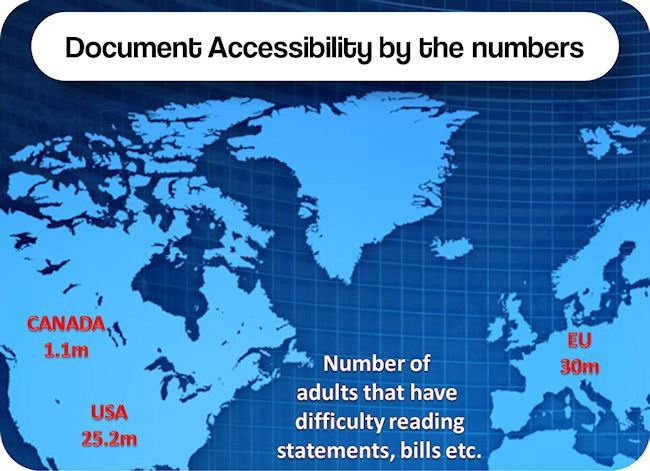For those that live in Canada, the topic of Accessibility for Ontarians with Disabilities Act (AODA) has started to become talked about finally by private industry. The legislation which became law in 2010 had compliance deadlines for many businesses of January 1, 2012 which were extended to the end of December 2012. The AODA has brought forward the need for additional processes for working with individuals with disabilities. For those reading this Blog who live and work in the USA, similar legislation is already in place via the ADA Act (updated 2008). For those of you reading this who live and work in the other provinces in Canada, it is simply a matter of time when similar legislation to the AODA will be tabled and passed (Manitoba is next in this regard).
Our experts in Accessibility at OPC have noticed many presentations & writings about the AODA are far too focused on removing barriers for those individuals with physical impairments and disabilities for example in physical building design; and how people with disabilities should be interacted with from a customer care perspective (thru the CSS).
The focus really needs to open things up and for the sake of this Blog today we turn our attention to Visual Disabilities and Visual Accessibility. With this in mind this also ties in with the IAS Phase of the AODA (Integrated Accessibility Standards) which will require accessibility with all printed customer communications, business documents, websites, signage and way-finding to name a few.
Think about some of the mail you still receive at home and at work; credit card statements, insurance policy declarations, bank statements and other documents via mail and electronic formats that are important to us. For those in the U.S and Canada with a visual impairment which can be anything from low vision to complete blindness, it is not possible to read and understand these types of documents without assistance from another person. These are the exact scenarios which have led to the increasing legislation that requires companies to offer alternate formats for documents to be produced in formats such as  Braille, Large Print, Audio and e-Text. This also applies to online PDF, Word, or HTML documents.
Braille, Large Print, Audio and e-Text. This also applies to online PDF, Word, or HTML documents.
In reading this Blog are you surprised to learn your company now needs to take your document production process and start adding alternate formats into your printing, mailing, and online availability processes via business document accessibility.
If you are in Ontario, Canada, the AODA will affect your business processes starting in 2013 and onwards. A good resource to review which describes some of the specifics of the IAS relative to the Communication and Marketing Phase, a document produced by Crawford Technologies is a useful resource to start with, AODA Printing: What you need to know. This article also outlines the risks for not complying with the new regulations.
Other regulations applicable to Canadian based companies include:
- Canadian Charter of Human Rights
- Access to Information Act
- CRTC Regulatory Policy 2009 Regulatory Policy
For those in the U.S., the requirements although not as directly prescriptive as the AODA, but do have requirements and carry potential litigation costs and penalties include:
- Americans with Disabilities Act (ADA)
- Rehabilitation Act , Sections 508 & 504
- ADA Title III: Public Accommodations Act
- Section 255 of the Telecommunications Act: Access for People with Disabilities
The fact of the matter for Canadian businesses is these regulatory requirements will start to impact all communications and marketing including printed material used to communicate with your customers.
In going forward it is critical to find a knowledgeable firm that will help your company to navigate the landscape of business document, internal communications, educational and training material, marketing material (think about your company’s annual reports for example) accessibility for individuals with visual disabilities.
Optimal Performance’s strategic consultants and accessible communication experts can help your company navigate the requirements and incorporate the solutions you need to meet Ontario & the US’s regulatory requirements. We can also show you how being the first amongst your competitors in being accessible to internal & external customers who have visual disabilities will enhance customer satisfaction, sales and customer loyalty.
Contact us at AODA@OptimalPerformance.ca to learn more about the AODA in Ontario and its impact on Communications and Marketing. Our experts can help you through the muddle to see the solutions clearly.


[…] The AODA and ADA in the impact on accessible documents for visually disabled customers (optimalperformanceblog.com) […]